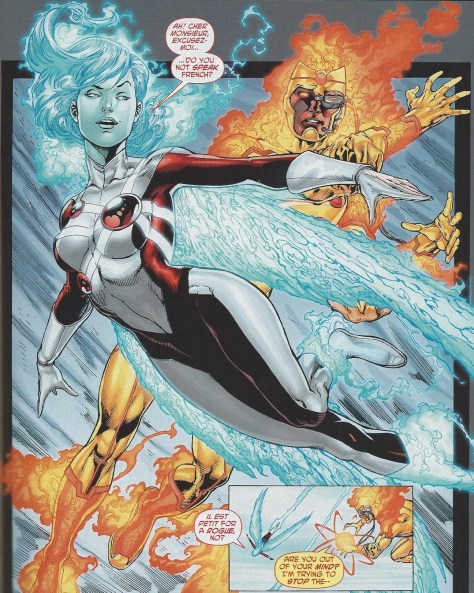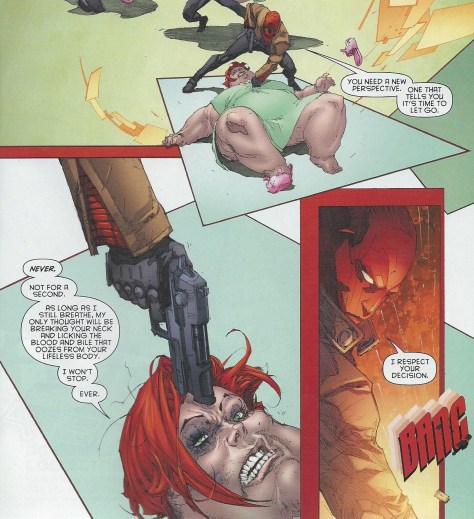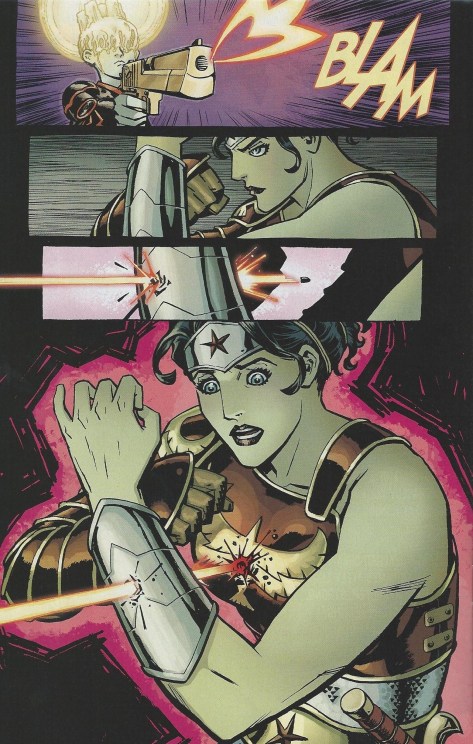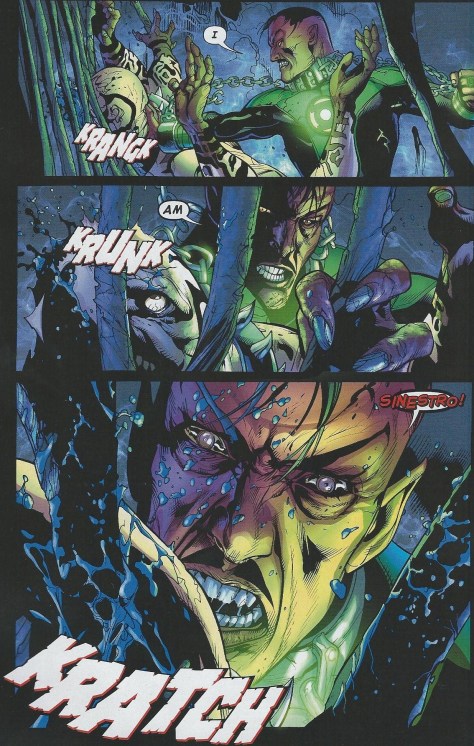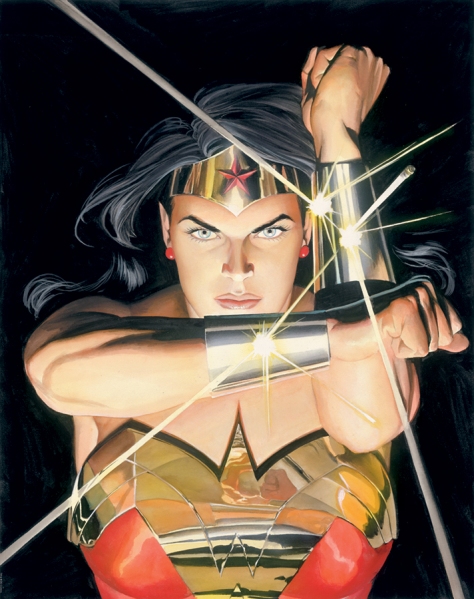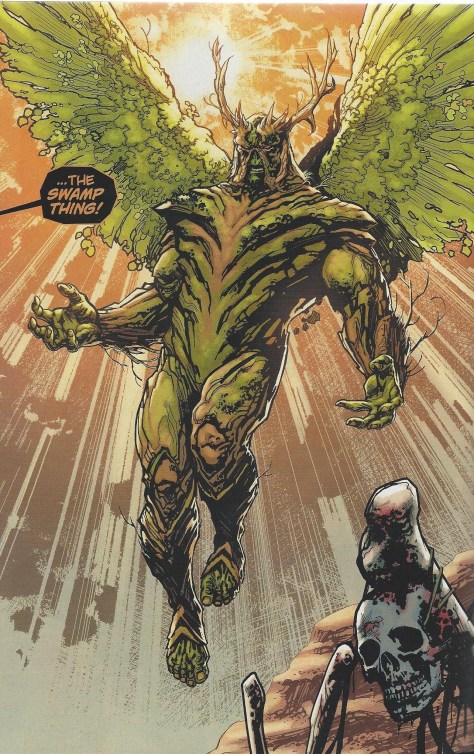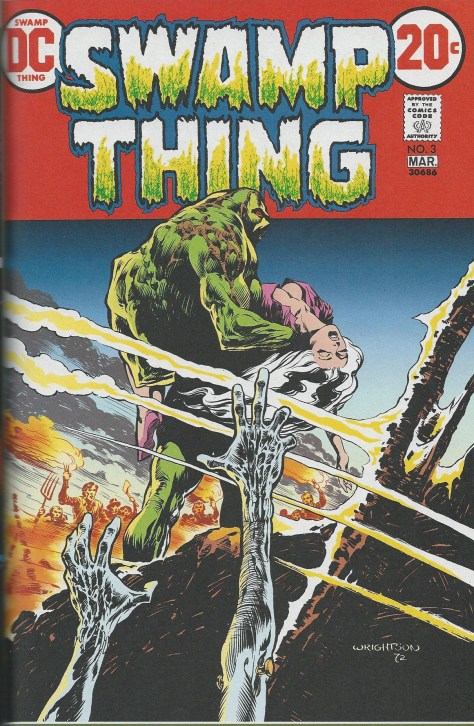This week has a lot of titles I have been anticipating for a sometime. That said I have high hopes for this batch of comics. Though it isn’t always the case, it seems that often they save the best for last. Well let’s see if that statistic holds up.
- Aquaman #8 continues in the trend of being rather short, but did some good exposition work on this enigmatic team, “The Others”, that Aquaman was part of before the Justice League. This issue portrays a very different Arthur than what we have seen thus far in the series. In fact he is much more akin to the Aquaman we’ve seen in the horrendous Justice League title. Maybe that shows hope that Geoff Johns will stop writing the latter title in such a horrible fashion. Probably not. But this series continues to be good, keeping his reputation as a writer “above water”, as it were . . .
- Green Lantern: New Guardians #8 has evolved greatly since the first four issues and shifted into what the title should be: an in depth look at corpsmen and women who exemplify the various Lantern groups they serve. Coming off the “Invictus” arc, not finishing it mind you, but coming off it into a . . . intermission . . . the issue also performs a secondary task of playing middleman to the other three Green Lantern Family books. Primarily this issue pertains to the main Green Lantern title where Sinestro has become a Green Lantern again, disbanding and helping to apprehend his former followers of the Yellow Corps, before being abducted to the Indigo homeworld. In this eighth issue of New Guardians, Sinestro’s chief lieutenant, Arkillo, goes back to Korugar, the Sinestro Corps homeworld, to find that the Corps is no more. In doing so, he is then put in the position of determining the fate of those remaining who follow the yellow light of Fear. The issue also segues Munk’s future participation in the “Secrets of the Indigo Tribe” arc in Green Lanterns well as Fatality’s position between the will of the Star Sapphires and her new team, the New Guardians. This is a fantastic series. I am glad I hung tight to it through the awkward burgeonings of the first four issues.
- Flash #8 was equally phenomenal, and truly an integral issue in setting the nature of the universe according to the Flash. We’ve been told about the Speed Force that grants Barry his powers as the Flash, as well as the catastrophic consequences attached to his usage of this fundamental energy. Last issue, Barry was shown going into the heart of the Speed Force. From this inside vantage we are shown the true nature of Barry’s connection to it, as well as how it has impacted the history of our planet and its dominant civilizations. Three villains are depicted herein, two familiar to any Flash fan and the other completely new and very intriguing. I won’t spoil the fun by telling you who any of them are, but just know that the two veteran ne’er-do-wells are iconic. And as ever the issues is written and rendered on the page to perfection by the consummate genius of writer/artists Brian Buccellato and Francis Manapul.
- Batman: The Dark Knight #8 seemed kind of lost. It didn’t tie into the past seven issues’ main plot line or resolve anything at all from last month. The only common thread it followed from those past issues is Commissioner Gordon being harassed by Internal Affairs lieutenant, Det. Forbes. I think part of the schizophrenia here stems from an interim creative team. Neither Paul Jenkins or David Finch who started the series’ reboot are involved. The story is written by newcomer Joe Harris and the art is done by Ed Benes of recent Red Lantern fame. Next month Finch appears to be back as artist, but Judd Winick is taking over writing for this issue only, to be followed afterward by Gregg Hurwitz for at least a full arcs worth of stories. This was an okay issue, but not up to the caliber that the series has displayed the past seven months.
- Superman #8 was also a little lackluster. It accomplished several things, but trailed off on others in disconcerting ways. It did portray the up in the air, chaotic nature of Clark Kent’s life, while also making him seem oafish and un-super. Check. It did introduce and explore further the history of Lord Helspont of the Deamonites, giving gravitas to his rebooted character. Check. What it didn’t do was give any kind of logical conclusion to the issue. The action just ends inexplicably and equally inexplicably Superman flies away and the conflict drops off with no resolution. Kind of a noodle scratcher. I think I liked it, but I’m not 100% certain.
- The Fury of Firestorm #8 continues to develop a very compelling world that is very evocative of the one we the readers live in. While it differs greatly from past runs and interpretations of the series and its characters, this iteration deals with nuclear proliferation in a very interesting tangent where human beings are made into living nuclear arsenals, having more power than all of the nuclear weapons of all the countries combined, added onto the fact that these weapons have human intellect and cunning. This issue furthers that exploration with the addition of a French Firestorm and a British Firestorm: Firehawk and Hurricane. The aforementioned Joe Harris, who penned this month’s Batman: The Dark Knight, is the new series writer teamed up with co-writer and artist Ethan Van Sciver. Both men do a stunning job making this series an intellectual action tour-de-force. I look forward to seeing what they have in store next month.
- Justice League Dark #8 finishes off its crossover arc with I, Vampire this week and I have to say that I am glad. I am not the biggest fan of the “Rise of Cain” story arc, nor I, Vampire, so good riddance on both counts. I will say that as ever the main reason that this issue was good was writer Peter Milligan. Milligan has been the heart and soul of this series and sadly this is his final issue, with Animal Man and Frankenstein writer Jeff Lemire coming on board next month for the ninth issue. You could tell in the tone and the subject material that this was a good bye. Not all of the cast of characters we’ve seen will continue on to the next arc, but despite that this issue provided a wonderful bookend to Milligan’s work and an ideal setup for Lemire to take over. The past two issues have been drawn by Daniel Sampere, and done beautifully, but next month artist Mikel Janin will return, bringing a note of continuity from the first 6 issues to the next phase of the storytelling.
- I, Vampire #8 was the usual claptrap. It featured what I am sure were supposed to be some mind blowing developments in the plot, but since the writer was unable to generate any substantial connection to or importance of the characters, it was just a major case of “Why do I care?” This will be the last issue of I, Vampire for me.
- Teen Titans #8 was really good and really set to work rounding out the characters. The Titans have been captured by N.O.W.H.E.R.E and what’s more, are being groomed for the impending “Culling”, a battle royale thinning of the young metahuman population by the nightmarish entity known as Harvest and his underling, Omen. The reintroduction of the veteran Teen Titan character, Lilith, also was interesting, as Scott Lobdell really has an epic storyline for this introductory opening arc. While these youths are imprisoned and prepped for the Culling, Omen and Harvest probe their consciousnesses and lay bare their fears, strengths, weaknesses, and primary drives. Red Robin is defined and his significance to Harvest’s plot hinted at, Solstice’s history is finally revealed, and the horror of Harvest revealed at the end. Next week begins the Culling with the Teen Titan Annual. I am excited.
- Voodoo #8 continues down a really strange path. Up until quite recently Voodoo seemed like a lost soul looking for righteousness and redemption, but with the reintroduction of the real Priscilla Kitaen its hard to tell where the plot can go from here. Unless writer Josh Williamson pulls a “Hail Mary” of story telling, its going to be hard to root for the main character of the book when she is so clearly working toward interests counter to those of her readers. I’m still invested in the story exactly for that reason and as ever Sami Basri’s art is top notch. This is a great series, but I pray that all this insanity that we are seeing is facilitating something larger.
- All-Star Western #8 was the last of the DC books I read this week, which is something of a tradition for me. I look forward to it every month and I find it a fitting tribute to save it for last. This month’s installment was worth the wait. Writers Justin Gray and Jimmy Palmiotti create a very authentic Western ambiance in yet another locale that is NOT classically viewed as the West. Jonah Hex and his Gothamite associate, Dr. Jeremiah Arkham, are in New Orleans tracking down a criminal from Gotham wanted for the abduction of children among other things, and in the mean time they have been drawn into ANOTHER plot, helping the vigilantes Nighthawk and Cinnamon combat xenophobic terrorists bent on murdering the influx of immigrants to the burgeoning “Big Easy.” Hex has infiltrated them, but the question remains as to how deep he’s gotten in and whether or not he can come back out. Moritat’s artwork of the series remains one of the most visually stunning of DC’s new lineup, right there with Yanick Paquette in Swamp Thing and Francis Manapul’s Flash. In the backup feature, also written by Gray and Palmiotti, we are given the back story of the vigilante, Cinnamon, from orphan of murdered parents to protege of a wandering samurai to sultry sidekick/paramour of Nighthawk, whom the backup feature introduced us to in last month’s issue. Patrick Scherberger provides the art here, and he does it with great detail and strong lines. This issue all together was capital “Q” quality
- Spaceman #6 continues to puzzle me. So much so that I’m not comfortable giving my impressions, as those impressions might be based on faulty information. As I said before, the plot jumps between one time period on Earth and another on the planet Mars, and while I believe Mars comes first I can’t prove that, so I am left scratching my head as to how the two correlate and what significance the Martian material has to do with the main plot on Earth. Eduardo Risso’s artwork is amazing. That is the most solid thing I can say about it. Brian Azzarello’s writing is very nuanced and stylized, but the downside of that is that its almost unintelligible like “Clockwork Orange.” Hopefully next month I can report something more.
- Green Hornet #24 brings us into the second of six issues in the “Outcaste” arc, and the stakes are perhaps the highest that they have ever been. The premise of the Green Hornet is that he and his partner Kato are good guys who masquerade themselves as villains to better combat organized crime. Well as we saw at the end of issue #23, a very well connected man in Century City has exploited that fact by having a fake Green Hornet kill several influential people, not least of whom includes the Mayor himself, allowing for a political vacuum which could spell big trouble for everyone in the municipality. Britt Jr has worked hard to live up to the legacy of his storied father in both his role as the Publisher of the Sentinel newspaper and as the dreaded Green Hornet. Now that he has finally gotten to the point where he feels he can live up to it, that same legacy is jeopardized by madmen. Along the way friendships and connections arduously formed to aid in his crusade begin to unravel. This is the start of perhaps the best Green Hornet story to date.
- Warlord of Mars #17 is on the penultimate chapter of the “Gods of Mars” arc. I am continually amazed by the skill and fidelity that the series shows to the original Edgar Rice Burroughs novels. I enjoyed the novels so much I thought it would be impossible for the comics to live up to those very evocative stories and images, yet somehow the Warlord of Mars team has done it. The key scenes and dialogue are all retained, but don’t feel watered down or condensed. The images are all there in stark, vibrant detail. These are the “Warlord of Mars” novels in full, translated into the comic medium.
- American Vampire #26 begins a new two part arc entitled “The Nocturnes.” As ever, writer/creator Scott Snyder really goes out of his way to make this series poignant and excellent. Its not just about Vampires in America and what they are, but rather what America is or has been, and how that shapes this emerging species of creature into what we’ve seen. Along those same lines, what really makes this series fun to read is that it started with two main characters and through the very personal storytelling, created a rich cast of side characters who inherit the spotlight as the series progresses. This storyline deals with our friend, Calvin Poole, from the “Ghost War” arc ten years later in the southlands of Alabama in 1954. As a taxonomist, he is the perfect mouthpiece to describe to us the evolution of vampires as a species, and as an African American taxonomist the perfect mouthpiece for the evolution of the American culture in the 1950’s. Roger Cruz takes over the art for series artist Rafael Albuquerque who is working on the backup features for Snyder’s ” Night of the Owls” in the main Batmantitle. His style is very reminiscent of Albuquerque’s so the issue fits in very neatly to the overall feeling of the series.
- The New Deadwardians #2 is shaping up to be a really incredible series. It reads a lot like a magical amalgam of the shows Downton Abbey and Walking Dead. Though they still haven’t used the word vampire, Dan Abnett pretty much has it sewn up that this is what the upper class of Britain has undergone to prevent being eaten by the zombie hoards that have infested their country. In this new world there is a tenuously balance of power among the “Young”, as the vampires call themselves, the “Bright” (the unaltered humans), and the zombie “Restless.” As of last issue a murder occurs on one of the Young and the three means of killing the young were not utilized. So the main question becomes what that means, and how that affects their supremacy over the Bright. This series is yet another example of giving a series a shot. I hate vampires and zombies and yet I am all about this series. If you are a fan of PBS and AMC, read this book . . .
- Kirby Genesis #7 reaches its penultimate chapter. This series has been incredible and I am sad to see that it is nearing its conclusion. As I’ve made abundantly clear in the past, Jack Kirby is one of the greatest geniuses of comics, if not the greatest. AS such, so many of his creations were never given their full due and this series has provided a platform for them to be seen again, or in some cases even get their own ongoing series, such as Silver Star, Captain Victory, and Dragonsbane. All three are incredible series in their own rights, but this main series featured so many other wonders of the Kirbyverse. I am further saddened that these other concepts will be put back in stasis again. The Midnight Swan, Garza Nights, and Galaxy Greens are incredible characters and fully worthy of their own series. Perhaps they will get them. In the interim, this issue showcased them all in the vivid artwork of Alex Ross and Jack Herbert. I look forward to and lament the release of the eighth and final issue
And so ends the month of April’s array of comics. May promises to be even better with an array of new series coming out as well as several Annuals. See you then . . .
Illustration Credits:
Green Lantern: The New Guardians #8: Drawn by Tyler Kirkham, Colored by Nei Ruffino, Inked by Batt
Fury of Firestorm #8: Art by Ethan Van Sciver, Colored by Hi-Fi
All-Star Western #8: Art by Moritat, Colored by Gabriel Bautista
American Vampire #26: Art by Roger Cruz, Colored by Dave McCaig

